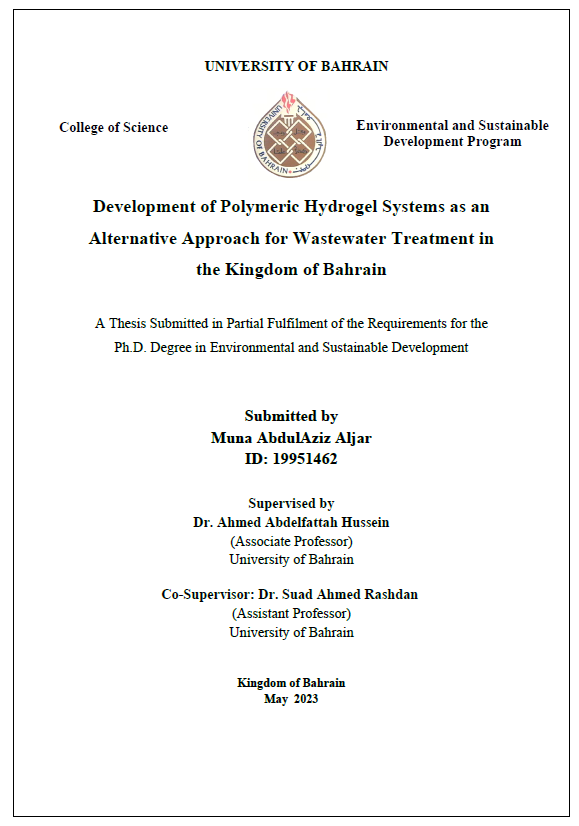Document
Identifier
https://digitalrepository.uob.edu.bh/id/4a757d9d-dfbb-4730-a974-8a4eccc5d730
Development of Polymeric Hydrogel Systems as an Alternative Approach for Wastewater Treatment in the Kingdom of Bahrain
Linked Agent
Hussein, Ahmed Abdelfattah , Thesis advisor
Date Issued
2023
Language
English
Extent
[1], 28, 303, [2] pages
Place of institution
Sakhir, Bahrain
Thesis Type
Thesis (Master)
Institution
"""University of Bahrain, College of Science, Department of Postgraduate Programs
English Abstract
Abstract:
The aim of this study is to prepare polymeric hydrogel beads as sustainable and
environmentally friendly adsorbents for the removal of organic dyes: Methylene Blue
MB and Congo Red CR) and heavy metals ions (Lead (Pb), Cadmium (Cd), Cobalt (Co)
and Zinc (Zn)) from aqueous solutions.
Green protocol based on physical crosslinking approach was used to fabricate various
adsorbent polymeric hydrogel structures and compositions using different types of
polymers (natural and synthetics) along with added nanoparticles and fillers. Two
porous hydrogel beads were designed; the first one was composed of Polyvinyl alcohol,
Alginate and natural Bentonite clay and was employed for the removal of organic dyes.
Whereas the second hydrogel beads were consisted of Alginate, Chitosan and Cellulose
and was used for the removal of heavy metals ions from aqueous solutions. The
structural analysis and morphology of the prepared adsorbents were investigated by
using different spectroscopic instruments such as Fourier Transform Infrared
spectroscopy, Scanning Electron Microscope coupled with energy dispersive X-ray
analysis and X-ray diffraction analysis. The adsorption capacity as well as kinetics and
isotherms analysis of the synthesized hydrogels were then investigated for the removal
of pollutants in aqueous solution. The stability and reusability of the fabricated
polymeric hydrogel adsorbents as low-cost environmentally friendly systems were
tested.
The results demonstrate the potential of (Polyvinyl alcohol, Alginate, and natural
Bentonite) hydrogels to remove organic dyes and (Alginate, Chitosan and Cellulose)
hydrogel for the removal of heavy metals ions from synthetic water systems. The
experimental results indicate that the incorporation of fillers (bentonite and cellulose)
in the nanocomposite formulation sustain the porous structure, preserve water uptake,
and increase the removal of dyes and heavy metals compared to the control beads
(hydrogels without fillers). Both adsorbents possessed high adsorption capacities and
fitted well to pseudo-second-order kinetic model with a high correlation coefficient.
Moreover, the designed beads had good stability and reusability as they exhibited
excellent removal efficiencies (90 %) for Methylene Blue, (75 %) for Congo Red,
(98.01 %) for Pb(II), (98.8 %) for Cd(II), (83.13 %) for Co(II) and (99.85 %) for Zn(II)
after six consecutive adsorption-desorption cycles. The maximum adsorption capacity
of the designed beads system as calculated by Langmuir isotherm for Methylene Blue,
Congo Red, Pb(II), Cd(II), Co(II) and Zn(II) were found to be 51.34, 16.193, 24, 24,
11.76, 12.5 mg/g respectively. Both semi-IPN nanocomposite Hydrogels beads
demonstrated good adsorbent properties and could be potentially used for the removal
of dyes and heavy metals ions from polluted water. The adsorption process was found
be combination of both monolayer adsorption on homogeneous surface and multilayer
adsorption on heterogeneous surface.
Member of
Category
Theses

